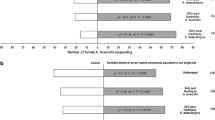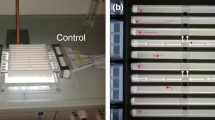Abstract
It is well known that herbivorous insects respond to host plant volatiles. Yet details of how these insects perceive the complex profile of volatiles from different potential host plants have not been studied for most insects. Gonipterus spp. are important pests of Eucalyptus worldwide, but differ in their preference for different species of this host. In this study, we consider whether host volatiles affect the host choice for a Gonipterus sp. and we characterize the response of the female insect to the volatile profiles from these hosts in an electro-antennographic experiment. We sampled volatiles from freshly damaged leaves of three Eucalyptus species and analysed the profiles by gas chromatography coupled to electro-antennography (GC-EAD) and gas chromatography coupled to mass spectrometry. Female weevils gave a mixed range of electro-physiological responses to volatile puffs from leaves of different tree species. This suggests that differences in volatile profiles of different trees play a role in how these beetles discriminate between potential hosts. GC-EAD analysis showed that responses were as complex as the volatile chemical compositions of the leaves. A number of these chemicals were identified, and responses were mostly due to general green leaf volatiles. This was also evident from the fact that the insects showed a markedly greater response to the total volatile profile from freshly damaged leaves for all species. The females of the Gonipterus sp. can therefore detect damaged leaves, which may indicate host quality. Host specificity information is further expected to lie in the relative differences in emission ratios and synergism between different host chemical compounds, rather than specific individual compounds.




Similar content being viewed by others
References
Addesso KM, McAuslane HJ, Alborn HT (2011) Attraction of pepper weevil to volatiles from damaged pepper plants. Entomol Exp Appl 138:1–11
Andersson MN, Larsson MC, Svensson GP, Birgersson G, Rundlöf M, Lundin O, Lankinen Å, Anderbrant O (2012) Characterization of olfactory sensory neurons in the white clover seed weevil, Apion fulvipes (Coleoptera: Apionidae). J Insect Physiol 58:1325–1333
Barata EN, Pickett JA, Wadhams LJ, Woodcock CM, Mustaparta H (2000) Identification of host and nonhost semiochemicals of the Eucalyptus woodborer Phoracantha semipunctata by gas chromatography-electroantennography. J Chem Ecol 26:1877–1895
Blight MM, Pickett JA, Wadhams LJ, Woodcock CM (1995) Antennal perception of oilseed rape, Brassica napus (Brassicaceae), volatiles by the cabbage seed weevil Ceutorhynchus assimilis (Coleoptera, Curculionidae). J Chem Ecol 21:1649–1664
Bray JR, Curtis JT (1957) An ordination of the upland forest communities of southern Wisconsin. Ecol Monogr 27:325–349
Brooker I, Kleinig D (1996) Eucalyptus: an illustrated guide to identification. Reed New Holland, Sydney. ISBN 1876334363
Bruce TJA, Wadhams LJ, Woodcock CM (2005) Insect host location: a volatile situation. Trends Plant Sci 10:269–274
Carbone SS, Rivera AC (1998) Sperm competition, cryptic female choice, and prolonged mating in the eucalyptus snout-beetle, Gonipterus scutellatus (Coleoptera, curculionidae). Etologia 6:33–40
Clark AF (1931) The parasite control of Gonipterus scutellatus gyll. NZJ Sci Technol 13:22–28
Clarke AR, Paterson S, Pennington P (1998) Gonipterus scutellatus oviposition on seven naturally co-occurring Eucalyptus species. For Ecol Manage 110:89–99
D’Alessandro M, Turlings TCJ (2006) Advances and challenges in the identification of volatiles that mediate interactions among plants and arthropods. The Analyst 131:24–32
Dicke M (2000) Chemical ecology of host-plant selection by herbivorous arthropods, a multitrophic perspective. Biochem Syst Ecol 28:601–617
Gailliard T, Matthew J (1976) Lipoxygenase-mediated cleavage of fatty acids to carbonyl fragments in tomato fruits. Phytochemistry 16:339–343
Guenther AB (1991) Isoprene and monoterpene emission rate variability: observations with Eucalyptus and emission rate algorithm development. J Geophys Res 96:10799–10808
Hanks LM, Millar JG, Paine TD, Campbell CD (2000) Classical biological control of the australian weevil Gonipterus scutellatus (Coleoptera: Curculionidae) in California. Environ Entomol 29:369–375
Harari AR, Landolt PJ (1997) Orientation of sugarcane rootstalk borer weevil, Diaprepes abbreviatus, to weevil, frass, and food odors. J Chem Ecol 23:857–868
Kalberer NM, Turlings TCJ, Rahier M (2001) Attraction of a leaf beetle (Oreina cacaliae) to damaged host plants. J Chem Ecol 27:647–661
Kotze MJ, Jürgens A, Johnson SD, Hoffmann JH (2010) Volatiles associated with different flower stages and leaves of Acacia cyclops and their potential role as host attractants for Dasineura dielsi (Diptera: Cecidomyiidae). S Afr J Bot 76:771–777
Lanfranco D, Dungey HS (2001) Insect damage in Eucalyptus: a review of plantations in Chile. Austral Ecol 26:477–481
Loch AD, Floyd RB (2001) Insect pests of the Tasmanian blue gum, Eucalyptus globulus, in south-western Australia: history, current perspectives and future prospects. Austral Ecol 26:458–466
Mally CW (1924) The Eucalyptus snout beetle Gonipterus scutellatus (Gyll.). J Dep Agric S Afr 9:3–31
Mapondera TS, Burgess T, Matsuki M, Oberprieler RG (2012) Identification and molecular phylogenetics of the cryptic species of the Gonipterus scutellatus complex (Coleoptera: Curculionidae: Gonipterini). Aust J Entomol 51:175–188
Matsui K, Ujita C, Fujimoto S, Wilkinson J, Hiatt B, Knauf V, Kajiwara T, Feussner I (2000) Fatty acid 9- and 13-hydroperoxide lyases from cucumber. FEBS Lett 481:183–188
Metcalf RL, Metcalf ER (1992) Plant kairomones in insect ecology and control. Chapman and Hall, London
Newete SW, Oberprieler RG, Byrne MJ (2011) The host range of the Eucalyptus Weevil, Gonipterus “scutellatus” Gyllenhal (Coleoptera: Curculionidae). Ann For Sci 68:1005–1013
Nunes TV, Pio CA (2001) Emission of volatile organic compounds from Portuguese Eucalyptus forests. Chemosph Glob Change Sci 3:239–248
Oksanen J, Blanchet FG, Kindt R, Legendre P, Minchin PR, O’Hara B, Simpson GL, Solymos P, Stevens MHH, Wagner H (2013) Community ecology package. R package version 2.0-10. http://cran.r-project.org, http://vegan.r-forge.r-project.org/
Pallini A, Janssen A, Sabelis MW (1997) Odour-mediated responses of phytophagous mites to conspecific and heterospecific competitors. Oecologia 110:179–185
Pio CA, Nunes TV, Castro LM, Lopes DA (2001) Volatile and particulate organic compounds in the ambient air of a Eucalyptus forest in Portugal during the FIELDVOC94 campaign. Chemosph Glob Change Sci 3:283–293
Proffit M, Johnson SD (2009) Specificity of the signal emitted by figs to attract their pollinating wasps: comparison of volatile organic compounds emitted by receptive syconia of Ficus sur and F. sycomorus in Southern Africa. S Afr J Bot 76:701–709
Richardson KF, Meakins RH (1984) Inter- and intra-specific variation in the susceptibility of eucalypts to the snout beetle Gonipterus scutellatus Gyll. (Coleoptera: Curculionidae). S Afr For J 139:21–31
Rivera AC, Carbone SS (2000) The effect of tree species of Eucalyptus on the growth and fecundity of the Eucalyptus snout beetle (Gonipterus scutellatus). Forestry 73:21–29
Rivera AC, Carbone SS, Andrés JA (1999) Life cycle and biological control of the Eucalyptus snout beetle (Coleoptera, Curculionidae) by Anaphes nitens (Hymenoptera, Mymaridae) in north-west Spain. Agric For Entomol 1:103–109
Slone DH, Sullivan BT (2007) An automated approach to detecting signals in electroantennogram data. J Chem Ecol 33:1748–1762
Späthe A, Reinecke A, Olsson SB, Kesavan S, Knaden M, Hansson BS (2012) plant species- and status-specific odorant blends guide oviposition choice in the moth Manduca sexta. Chem Senses 38:147–159
Sun XL, Wang GC, Gao Y, Chen ZM (2012) Screening and field evaluation of synthetic volatile blends attractive to adults of the tea weevil, Myllocerinus aurolineatus. Chemoecology 22:229–237
Tooke FGC (1953) The Eucalyptus Snout-beetle, Gonipterus scutellatus Gyll. A study of its ecology and control by biological means. Entomology Memoir 3. Department of Agriculture, Pretoria, South Africa, pp 1–53
Van den Berg J, Torto B, Pickett JA, Smart LE, Woodcock LJWCM (2008) Influence of visual and olfactory cues on field trapping of the pollen beetle, Astylus atromaculatus (Col.: Melyridae). J Appl Entomol 132:490–496
van Tol RWHM, Visser JH (2002) Olfactory antennal responses of the vine weevil Otiorhynchus sulcatus to plant volatiles. Entomol Exp Appl 102:49–64
van Tol RWHM, Visser JH, Sabelis MW (2002) Olfactory responses of the vine weevil, Otiorhynchus sulcatus, to tree odours. Physiol Entomol 27:213–222
Visser J (1986) Host odor perception in phytophagous insects. Annu Rev Entomol 31:121–144
Weissbecker B, Loon JJAV, Dike M (1999) Electroantennogram responses of a predator, Perillus bioculatus, and its prey, Leptinotarsa decemlineata, to plant volatiles. J Chem Ecol 25:2313–2325
Williams JR, Moutia LA, Hermelin PR (1951) The biological control of Gonipterus scutellatus Gyll. in Mauritius. Bull Entomol Res 42:23–28
Acknowledgments
We are grateful to the members of the Tree Protection Co-operative Programme (TPCP), the THRIP initiative of the Department of Science and Technology (DST), South Africa and the National Research Foundation (NRF) for providing financial support for this study. We also thank Dr. Jeff Garnas for assistance with some of the statistical tests and for providing unpublished data pertaining to the identification of the Gonipterus sp. used in this study.
Author information
Authors and Affiliations
Corresponding author
Additional information
Handling Editor: Anna-Karin Borg-Karlson.
Electronic supplementary material
Below is the link to the electronic supplementary material.
11829_2014_9327_MOESM1_ESM.pdf
Supplementary Fig. 1 Non metric multidimensional scaling (NMDS) plot based on the mass spectral integration data for the 16 compounds confirmed with reference standards for each species. The plot shows the Bray–Curtis distance rotated so that the variance is maximized on the first dimension. Numbers indicate compound identity as in Tables 2, 3 and 4. Stress ≈ 0 (PDF 5 kb)
Rights and permissions
About this article
Cite this article
Bouwer, M.C., Slippers, B., Wingfield, M.J. et al. Chemical signatures affecting host choice in the Eucalyptus herbivore, Gonipterus sp. (Curculionidae: Coleoptera). Arthropod-Plant Interactions 8, 439–451 (2014). https://doi.org/10.1007/s11829-014-9327-y
Received:
Accepted:
Published:
Issue Date:
DOI: https://doi.org/10.1007/s11829-014-9327-y




